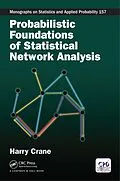The book discusses fundamental considerations for modeling network data of various kinds. The book's major novelty is the emphasis on understanding and building models from first principles, rather than choosing from a list of models that are already available. A main goal of the book is to explain the logic and rationale behind the technical aspects of recent work on network modeling and to discuss how those considerations compare to alternative approaches.
Autorentext
Harry Crane is Associate Professor and Co-Director of the Graduate Program in Statistics and Biostatistics and an Associate Member of the Graduate Faculty in Philosophy at Rutgers University. Professor Crane's research interests cover a range of mathematical and applied topics in network science, probability theory, statistical inference, and mathematical logic. In addition to his technical work on edge and relational exchangeability, relative exchangeability, and graph-valued Markov processes, Prof. Crane's methods have been applied to domain-specific cybersecurity and counterterrorism problems at the Foreign Policy Research Institute and RAND's Project AIR FORCE.
Zusammenfassung
Probabilistic Foundations of Statistical Network Analysis presents a fresh and insightful perspective on the fundamental tenets and major challenges of modern network analysis. Its lucid exposition provides necessary background for understanding the essential ideas behind exchangeable and dynamic network models, network sampling, and network statistics such as sparsity and power law, all of which play a central role in contemporary data science and machine learning applications. The book rewards readers with a clear and intuitive understanding of the subtle interplay between basic principles of statistical inference, empirical properties of network data, and technical concepts from probability theory. Its mathematically rigorous, yet non-technical, exposition makes the book accessible to professional data scientists, statisticians, and computer scientists as well as practitioners and researchers in substantive fields. Newcomers and non-quantitative researchers will find its conceptual approach invaluable for developing intuition about technical ideas from statistics and probability, while experts and graduate students will find the book a handy reference for a wide range of new topics, including edge exchangeability, relative exchangeability, graphon and graphex models, and graph-valued Levy process and rewiring models for dynamic networks.The author's incisive commentary supplements these core concepts, challenging the reader to push beyond the current limitations of this emerging discipline. With an approachable exposition and more than 50 open research problems and exercises with solutions, this book is ideal for advanced undergraduate and graduate students interested in modern network analysis, data science, machine learning, and statistics. Harry Crane is Associate Professor and Co-Director of the Graduate Program in Statistics and Biostatistics and an Associate Member of the Graduate Faculty in Philosophy at Rutgers University. Professor Crane's research interests cover a range of mathematical and applied topics in network science, probability theory, statistical inference, and mathematical logic. In addition to his technical work on edge and relational exchangeability, relative exchangeability, and graph-valued Markov processes, Prof. Crane's methods have been applied to domain-specific cybersecurity and counterterrorism problems at the Foreign Policy Research Institute and RAND's Project AIR FORCE.a a a a a a
Inhalt
Dedication
Preface
Acknowledgements
- Orientation
- Binary relational data
- Network sampling
- Generative models
- Statistical modeling paradigm
- Vertex exchangeable models
- Getting beyond graphons
Analogy: Bernoulli trials
What it is: Graphs vs Networks
Moving beyond graphs
How to look at it: Labeling and representation
Where it comes from: Context
Making sense of it all: Coherence
What we're talking about: Common examples of network data
Internet
Social networks
Karate club
Enron email corpus
Collaboration networks
Other networks
Some common scenarios
Major Open Questions
Sparsity
Modeling network complexity
Sampling issues
Modeling temporal variation
Chapter synopses and reading guide
Binary relational data
Network sampling
Generative models
Statistical modeling paradigm
Vertex exchangeable models
Getting beyond graphons
Relatively exchangeable models
Edge exchangeable models
Relationally exchangeable models
DEDICATION
Dynamic network models
Scenario: Patterns in international trade
Summarizing network structure
Dyad independence model
Exponential random graph models (ERGMs)
Scenario: Friendships in a high school
Network inference under sampling
Further reading
Opening example
Consistency under selection
Consistency in the p model
Significance of sampling consistency
Toward a coherent framework of network modeling
Selection from sparse networks
Scenario: Ego networks in high school friendships
Network sampling schemes
Relational sampling
Edge sampling
Hyperedge sampling
Path sampling
Snowball sampling
Units of observation
What is the sample size?
Consistency under subsampling
Further reading
Specification of generative models
Preferential Attachment model
Random walk models
Erd os-R enyi-Gilbert model
General sequential construction
Further reading
The quest for coherence
An incoherent model
What is a statistical model?
Population model
Finite sample models
Coherence
Coherence in sampling models
Coherence in generative models
Statistical implications of coherence
Examples
Erd os-R enyi-Gilbert model under selection sampling
ERGM with selection sampling
Erd os-R enyi-Gilbert model under edge sampling
Invariance principles
Further reading
Preliminaries: Formal definition of exchangeability
Implications of exchangeability
Finite exchangeable random graphs
Exchangeable ERGMs
Countable exchangeable models
Graphon models
Generative model
Exchangeability of graphon models
Aldous-Hoover theorem
Graphons and vertex exchangeability
Subsampling description
Viability of graphon models
Implication: Dense structure
Implication: Representative sampling
The emergence of graphons
Potential benefits of graphon models
Connection to de Finetti's theorem
Graphon estimation
Further reading
Something must go
Sparse graphon models
Completely random measures and graphex models
Scenario: Formation of Facebook friendships
Network representation
Interpretation of vertex labels
Exchangeable point process models
Graphex representation
Sampling context
Further discussion
Variants of invariance
Relatively exchange…
